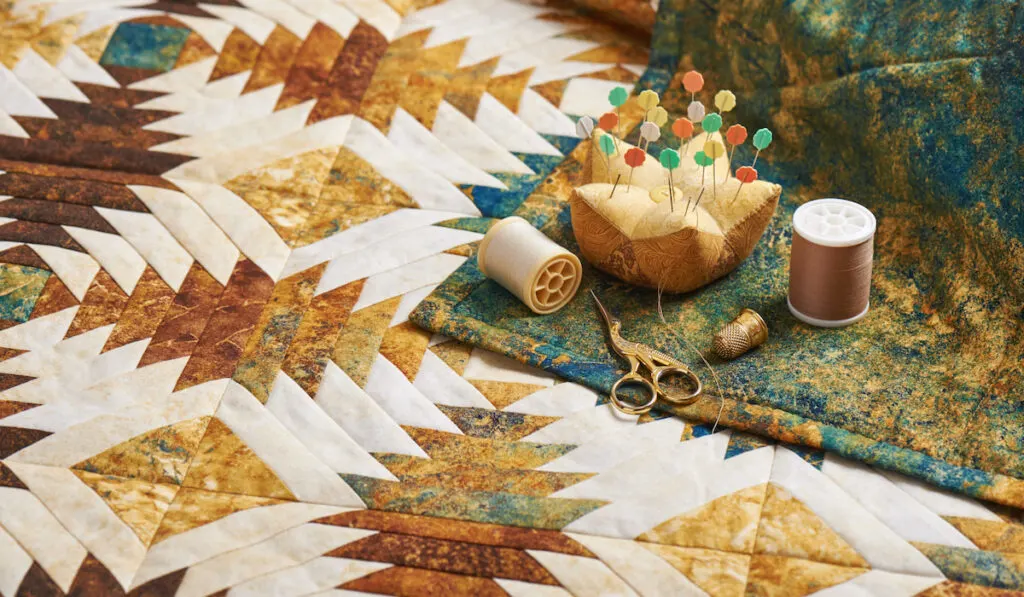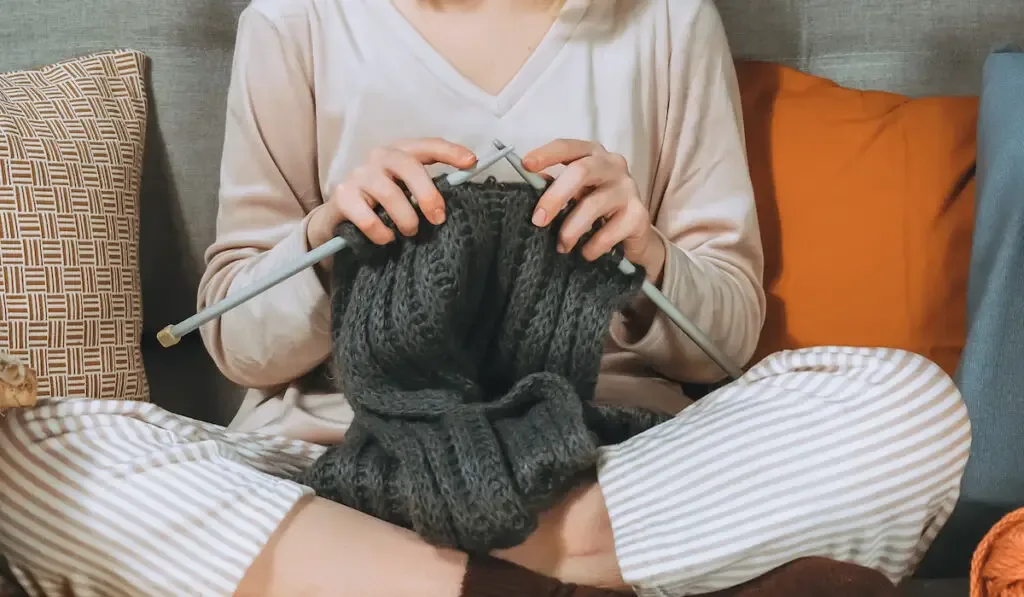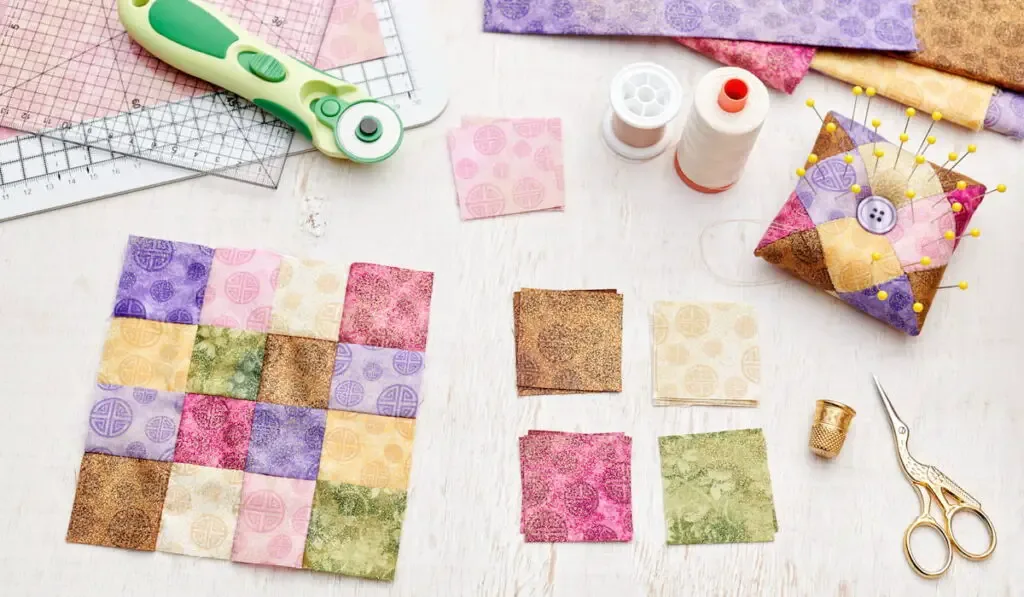Some less experienced in the threaded arts would think “Oh, there’s a needle and thread, so it must all be essentially the same thing,” with ‘all’ being defined as any sewing or stitching technique that uses some sort of needle to weave a type of thread.
However, those with experience will know that tools, materials, techniques, and the products produced are very different across each type of material weaving.
In this article, we will explore the key differences between quilting and knitting. Don’t worry! It may seem overwhelming, but we’ll take it slow and give you the basic differences.
So, no stress; grab a notebook, pencil, and your wallet and let’s get you prepared to know exactly what you need in order to succeed!

What Is Quilting? Sounds Like It’s Specifically For Quilts, Is That Correct?
Well, yes and no. Quilting is a method of sewing where you stitch multiple rows of stitches using thread into two layers of the fabric of your choice.
In between these layers, there is commonly found to be a layer of plushy material or insulating material.
Quilting does not simply sew on the outskirts of the material to keep them all together in a coherent shape. It also sews in the middle or across the entire piece of material and can be done in specific patterns.
Some sewing machines used for quilting have built-in designs such as swirls and leaves and flowers which add a layer of design and aesthetic to your quilt, having not only the fabric be visually appealing but also the stitches, too.
Today, quilting is typically reserved for making quilts, but in past time periods, it was used for clothing purposes. In cold regions such as Northern Europe, and also in places such as China, North Africa, and the Middle East, people would use the above quilting method to make clothing.
Have you ever seen pictures or paintings or even the clothes themselves of ancient Chinese citizens? Notice how their traditional wear was a thick, padded kind of material that looked like plushy armor, something you’d wear to a pillow fight?
Well, that’s quilted clothing! It may seem weird, but it probably kept them fairly warm in the cold weather and came in handy if someone tried to throw a punch.

What Is Knitting, Then? Is It Quilting but With a Different Outcome than a Quilt?
This is where we can give you a definite no. Knitting and quilting share the threading family, but they are accomplished very differently.
Knitting uses two large needles called knitting needles and yarn as the thread.
The knitting technique is a process of interlocking loops of yarn creating a tightly woven mesh net of fabric. Yarn is looped around the needles, then pulled through into a stitch, joining the rest of the material in the fabric.
Knitting is used to create all types of objects: clothes such as hats, scarves, cardigans and sweaters, even t-shirts, blankets, stuffed animals, stockings, and much more. Knit fabrics are very flexible and stretchy, making them a highly desired and comfortable clothing technique.
Knitting was invented during the fifth century in Egypt and the Middle East. Egyptians would knit cotton into clothing articles. International trade introduced the technique to Europe where it was quickly adopted. European workmen, such as fishermen, adopted knitting to create hearty wool articles that would keep them warm and protect them from the sea’s unpredictable weather when out fishing.
At the same time, the upper class has undergarments knitted for them as well due to the flexibility and comfort the resulting garments provide.
Later, knitting became more popular and available to the public, and factories were started where people would knit garments, making knitted woolen or cotton clothing commercially for common fashions among everyone. Knitting looms were invented in 1816 and they sped up the production process for knitted materials, making fabrics available to clothiers in greater quantity, quality, and variability.
Machine-operated looms are used today to mass-produce clothing much faster and more uniformly than knitting by hand does. However, knitting by hand is becoming popular again as people want to create homemade, unique articles as a hobby.

The Pros and Cons of Knitting versus Quilting
Quilting requires a lot of physical space. You need to plan out your quilt, especially if it is patchwork, and you’ll need a large space to spread and arrange your fabric on and to keep it there without it getting moved, lost, or ruined.
A dedicated sewing room may be necessary, where you can lay out your quilt on a table and lock the door without worrying about it getting shoved aside for dinner. Or, there are certain wall tools you can use to pin up your quilt and plan it there.
By hanging a certain kind of styrofoam board covered in a layer of fabric on the wall, you can place your quilt pieces and fix them together, planning out your entire quilt design without laying it horizontal and taking up the whole room!
You can sew the quilt in small pieces to save room, but if you’re quilting one big piece of fabric (and eventually your patchwork quilt will be that big), you’ll need a lot of space not just for your sewing machine but for your quilt to lay on the same height level nearby to move it freely in the machine, getting the design you want.
Putting it up on the wall will save it from getting scattered and lost over time, but eventually, you will need a big enough space and table to be able to complete your project.

Quilting also requires a lot of materials, including cutters, a cutting mat, scissors, fabric, pens for marking the fabric, and more.
The things you quilt aren’t very functional, either. You can quilt quilts, which are useful as a throw blanket or as a comforter for the bed. Making a wall quilt is only functional for a wall tapestry as art. And you can make table runners and other little things like that, but how often do you use those?
You could go back to Ancient China times and make clothes using quilting, but in modern days only quilted jackets are seen anymore, and the number of people wearing those is very few.
Knitting, on the other hand, only uses two things: knitting needles and yarn. It does not need its own designated space, either. You can knit in the living room in front of the TV, on the porch, in your bed, and you can even take it with you when you go places!
You just need to keep track of your yarn, and the project gets bigger as you knit, so maybe if you’re knitting a blanket you’ll want to keep it at home. But small projects you can leave in your bag or put in a drawer and that’s all the storage you need.
The functionality of knitted items is much broader, too. You can knit essentially all clothing items except shoes (unless you want fluffy knitted slippers to wear around the house), plus so many other things including bags, blankets, stuffed animals, and more.
So, in all knitting is a much more flexible and portable option for your weaving desires, but if you’re wanting a specific effect and design for your child’s bedroom décor, go for the quilting.

To Sum It Up, What Are the Differences Between Knitting and Quilting?
While quilting and knitting both use needles and a type of thread, the technique used to create their projects is quite different.
Quilting uses either one small metal needle with thread to hand-sew, or a sewing machine that guides the fabric along with the machine. Knitting uses two large needles and thicker thread called yarn for hand-knitting, and a loom for quicker or mass production.
Knitting is much more versatile, making all varieties of clothes and functional household objects. You can knit anywhere around your home or out in public, with no dedicated storage or materials needed other than your needles and yarn.
Quilting is much more set in terms of location, needing a dedicated sewing room (even if its a temporary dedicated sewing room) to layout your materials, arrange them, cut and mark them, sew on a table that will hold the whole quilt, and to store it when you are gone (unless you can lock the door).
However, the result of quilting can be incredible.
With knitting, it is a few simple techniques that ultimately give a fine to coarsely woven (depending on the string/thread will make it extremely thin and tight like in shirts at clothing stores, or loose and holey like hand-knitted scarves and hats) look to your project, while quilting’s stitching can be much more diverse.
Quilting uses stitching to keep the quilt together, but can also add an extra layer of design to the already fashionable fabric by adding swirls and leaves and lines across the quilt and enhancing the fabric.
Quilting teaches you that stitches don’t need to just hold the quilt together– they can be the star of the design.
The Bottom Line
Did this help? Hopefully, you’ve learned a little more about the history, uses and technique of quilting and knitting, along with the differences and pros and cons of both.
Maybe you’re a newbie and want to know which method is best for your project, or maybe you’re a quilter or knitting enthusiast hoping for a new branch to explore.
Whatever the case, and whichever you choose, you will not regret it. The casual nature of knitting and the beauty of quilting will make all of your time and effort worthwhile!
